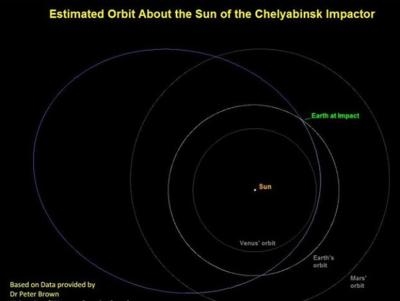Wed, Feb 20, 2013
Largest Such Event In More Than A Century
The first firm details of the meteor impact which occurred Friday in Russia, the largest in more than a century, are becoming clear. ESA is carefully assessing the information as crucial input for developing the Agency’s asteroid-hunting effort.

According to the ESA, at 0320 GMT on February 15, a natural object entered the atmosphere and disintegrated in the skies over Chelyabinsk, Russia. Extensive video records indicate a northeast to southwest path at a shallow angle of 20° above the horizontal. The entry speed is estimated at around 18 km/s, or more than 40,000 miles per hour. According to calculations by Peter Brown at the University of Western Ontario, Canada, drawing on extremely low-frequency sound waves detected by a global network, the object is estimated to have been about 55 feet across with a mass of about 10,000 tons when it entered the atmosphere. It exploded with a force of nearly 500 kilotons of TNT – some 30 times the energy released by the Hiroshima atomic bomb – at an altitude of under 65,000 feet.
With our current understanding of near-Earth objects, ESA says that events of this magnitude are expected once every several of tens to 100 years.
Detlef Koschny, who monitors near-Earth objects for ESA’s Space Situational Awareness (SSA) program, said that an the majority of the damage was caused by the airburst resulting in window breakage and some structural damage in downtown Chelaybinsk. Normally, some damage begins to occur at around five times normal air pressure at sea level. Widespread window damage is expected around 10–20 times this value. As the explosion and fireball progressed along a shallow trajectory, the cylindrical blast wave would have propagated directly to the ground and would have been intense.
Koschny said the terminal part of the explosion probably likely occurred almost directly over Chelyabinsk. This was perhaps the single greatest contributor to the blast damage. "We are waiting for confirmation from the Russian authorities that pieces of the object – bits of meteorite – have been found in the region," he said. "We’re unaware of any media reports of anyone or any structure being hit by any debris from the object itself."
(Graphic provided by ESA)
More News
An Amazing Experience Awaits The Chosen Few... Oshkosh, to us, seems the perfect place to get started on watching aviation recover the past couple of years... and so ANN is putting>[...]
“NBAA has a tremendous responsibility to the business aviation industry, and we are constantly collaborating with them. Our flight departments, professionals and aircraft own>[...]
Dead Reckoning Dead reckoning, as applied to flying, is the navigation of an airplane solely by means of computations based on airspeed, course, heading, wind direction, and speed,>[...]
Aero Linx: Vertical Aviation Safety Team (VAST) We are a public–private initiative to enhance worldwide flight operations safety in all segments of the vertical flight indust>[...]
We're Everywhere... Thanks To You! Even with the vast resources and incredibly far-reaching scope of the Aero-News Network, every now and then a story that should be reported on sl>[...]
 ANNouncement: Now Accepting Applications For Oshkosh 2024 Stringers!!!
ANNouncement: Now Accepting Applications For Oshkosh 2024 Stringers!!! Aero-News: Quote of the Day (06.13.24)
Aero-News: Quote of the Day (06.13.24) ANN's Daily Aero-Term (06.13.24): Dead Reckoning
ANN's Daily Aero-Term (06.13.24): Dead Reckoning ANN's Daily Aero-Linx (06.13.24)
ANN's Daily Aero-Linx (06.13.24) ANN FAQ: How Do I Become A News Spy?
ANN FAQ: How Do I Become A News Spy?



